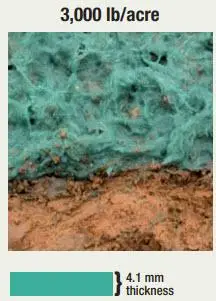Mulch Considerations and Seeding Techniques

There are several mulch and seeding options. Each option has its benefits and required considerations.
Slit/Drill Seeding:The installation of seed using an attachment on a tractor that tills openings/slits in the soil for the seed to be deposited. After seeding mulch may be applied via Straw Blower or rolled matts, or not. Slit/Drill seeding requires additional seeds (at least from us) to ensure adequate application rates.
BROADCAST SEEDING: The installation of seed using an attachment on a tractor that spreads seed over a site. After seeding mulch will typically be applied via Straw Blower or rolled matts.
HYDROSeeding: The accurate installation of seed using water as a carrier to evenly distribute seed. Hydroseeding can also be used to apply amendments (fertilizer/soil Ph amendments). After seeding mulch will be required via Straw Blower or rolled matts.
HydroMULCHING: A combination of Hydroseeding and Mulching. Commonly called hydroseeding. Hydromulching includes the addition of mulch providing time savings on installation (seed and mulch in a single step). Hydromulching is faster than all other seeding seeding techniques and can provide better sediment control than other options. Seed, fertilizer, lime, mulch, tackifier and other amendments are installed in one step.
Mulch Selection: The largest variable in cost (other than seed selection) are the mulch and tackifier requirements. Mulch requirements are typically specified by type and rate (eg Straw Mulch at 2 Tons per Acre). One of the benefits of hydroseeding is the variations of mulch and tackifier options. There are tackifiers that enable seeding slopes of 1 to 1 with no variation of mulch required.
Straw Mulch: The most common specified mulch by the Department of Transportation (DoT) and the US Army Corps of Engineers (USACE). Straw mulch has a long history of reducing sediment in our waterways and improving the probability of establishing permanent ground cover on relatively flat sites. Soil preparation occurs, followed by seeding, then straw is spread on the site and lastly a tackifier (glue) is applied to keep the straw in place, straw tackifier is normally either a emulsified asphalt or Polyacrylamide (PAM).
RECP (Rolled Erosion Control Products):Temporary or Permanent rolled matts designed to prevent soil erosion while protecting vegetative growth and help to keep seeds in place allowing root development while reducing the potential for root rip out with highwater flow. Biodegradable netting options are available as are compositions of straw, excelsior, coconut, or plastic.
Tackifier’s: A water soluble glue that is mixed in the hydroseeder with mulch to keep seed, mulch, and soil on the seeded site. There are different tackifiers available for different site conditions (or to meet engineer specifications). Common tackifiers available include PAM ( Polyacrylamide), Guar, and Earth Guard (a proprietary liquid tackifier).
mulch options/selection:
Paper/Cellulose Mulch: 100% recycled paper ideal for general seeding on flat lots with mild weather effects. Max slope length of 15 feet with a longevity of less than 3 months. Can also be mixed with a tackifier and used to tack straw in place, or be used a seeding technique prior to using RECPs.
Blended Mulch: A mix of Cellulose mulch with a fibered mulch (wood or other) free from plastic netting, and forms an intimate bond with the soil surface creating a porous, absorbent and flexible erosion resistant blanket. Applied to flat to mild slopes (3H:1V) or as steep as 2H:1V with EarthGuard Tackifier.
Wood Mulch: Wood chips that are thermally refined to create fine, long and highly absorbent fibers that maintain their water-holding ability enabling them to enhance germination and growth. Slopes typically of 2H:1V or less (steeper depending on tackifier).
Flexible Growth Medium (FGM): Our premium mulch provides: ~99% erosion control effectiveness immediately upon application, bonds directly to soil providing superior erosion control, faster lay down and lower installed cost than rolled blankets, and minimizes soil loss and turbidity of effluent runoff. Slopes at steep as 1H:1V.
Flexterra is our preferred mulch for dormant seeding due to immediate protection on bare soil and its functional longevity of up to 18 months that enables that when growing conditions arrive, the sees are still in place for germination and emergence.
ProGanics Dual:
Mulch Application Rates: Rate varies based on Mulch and Slope
500#/Acre (seeding only or straw tac)
1,500#/Acre : >4/1 (Early spring)
2,000#/Acre > 3/1 (Standard mix)
3,000#/Acre >2/1
3,500#/Acre 2/1
4,000#/Acre >1/1